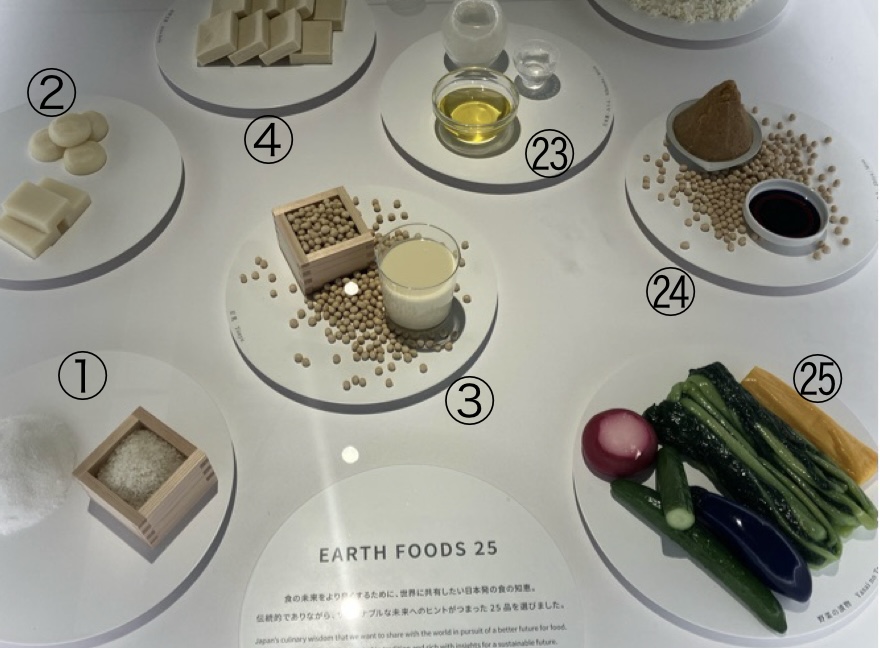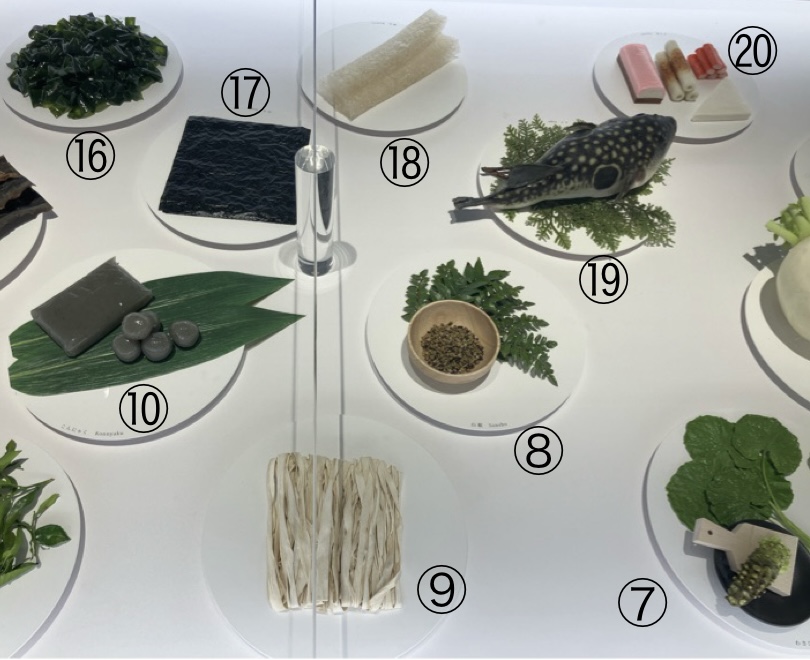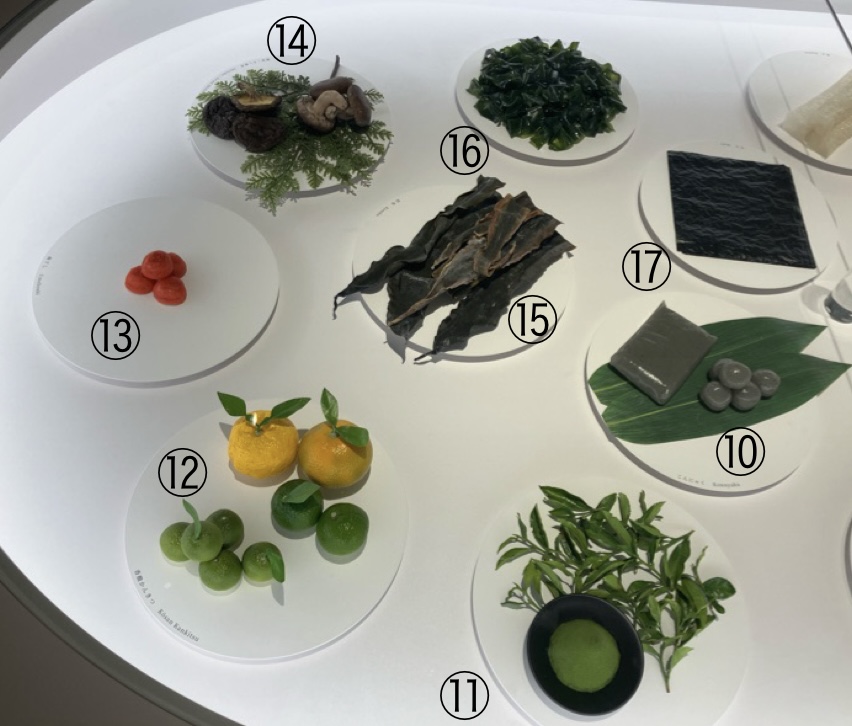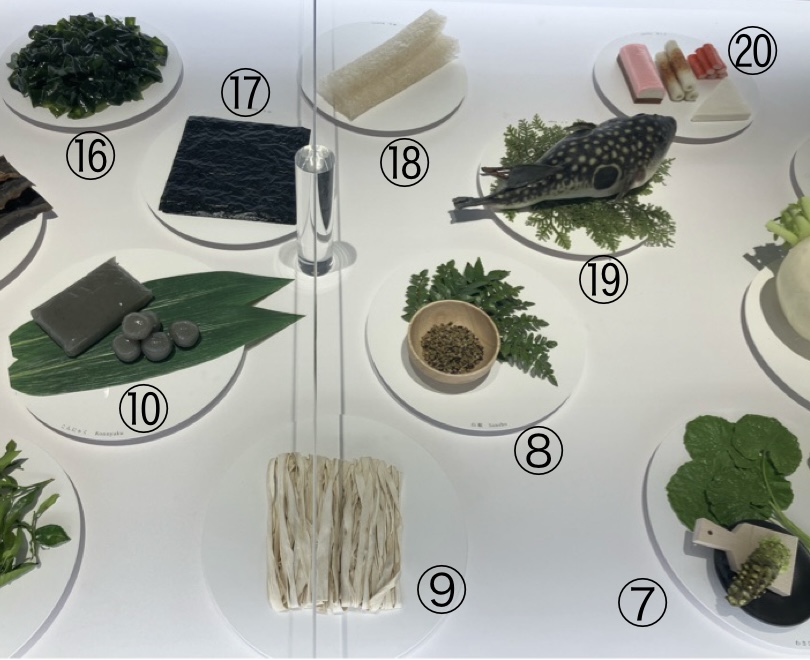
日本が世界にほこれるアースフーズの紹介です。
万博に行ってきました。「アースマート」館では、食の未来をよりよくするために、世界に知ってほしい日本の食べ物のリストを「アースフーズ25」と名付けて発表しています。
最近、日本食のよさが世界で認められています。
日本食は、①とても健康的で、②栄養バランスもよく、③地域でとれる新鮮な食材や、④それぞれの季節にあう食材を使いつつ、⑤行事に合わせた食事や⑥美しい配色を意識した献立も多いです。
そのような日本食のよさをいかせる25の食材は次の通りです。
① 米粉:日本の主食である米を粉状にしたもの。
② 餅:餅米などを蒸して、臼と杵を使って粘り気が出るまでついて作る保存食。

③ 豆乳:大豆を原料にしたミルクに代わる飲み物。
④ 高野豆腐:豆腐を凍らせたあとに低い温度で熟成し、乾かせた保存食。
⑤ あんこ:小豆などを煮詰めて、細かくすりつぶしたもの。和菓子によく使われる。

⑥ 大根:日本で古くから親しまれている白くて太い根野菜。
⑦ わさび:鼻につんとくる辛みがあり、香辛料として使われる日本の野菜。
⑧ 山椒:豊かな香りと、辛み、しびれがある蜜柑科の植物。
⑨ かんぴょう:夕顔の実(果肉)を薄く細長くむいて乾燥させたもの。
⑩ こんにゃく:こんにゃく芋から作られ、ぷるぷるした食感のある食品。

⑪ 抹茶:日光を当たらないように、摘み採り、揉まずに乾燥した茶葉を細かくしたもの。
⑫ 香酸かんきつ:果肉(実)を食べないで、果汁の酸味や皮の香りを楽しむもの。ゆず、だいだいやかぼず、すだちなど。
⑬ 梅干し:梅の実を塩だけで漬けた、酸っぱい食べ物。

⑭ 椎茸・干し椎茸:ぶな科の枯れ木に生える日本を代表するきのこ。
⑮ 昆布:うま味と栄養豊富たっぷりの海藻。
⑯わかめ:ほぼすべて食べることができる褐藻類の海藻。
⑰ のり:主に、紅藻類を加工した乾燥食品。巻く、はさむ、ふりかけるなど多様な使い方ができる。
⑱ 寒天:海藻のてんぐさなどを煮出した液を冷やし固めてつくる「ところてん」を凍らせて、乾燥させたもの。
⑲ ふぐ:おいしい高級魚。養殖がしやすい魚。
⑳ すり身:魚の身をすりつぶした練りもので、かまぼこ、はんぺん、ちくわ、さつま揚げなどに加工できる。
㉑ 鰹節:かつおの身を煮出して固めたあと、いぶして乾燥させたもの。
㉒ 麹・種麹:かびの一種「麹菌」を蒸した米や麦、大豆などに付着させ増やしたものが「麹」。麹をつくるときに麹菌の種として用いられるのが種麹。日本酒やみそ、しょうゆ、みりん、酢など日本で使われている発酵食品に使われる。
㉓ 日本酒・本みりん:日本酒は、米・米麹・水を原料に発酵させたお酒。本みりんは餅米・米麹・焼酎を原料に作った調味料。
㉔ しょうゆ・みそ:大豆、塩などを原料とし、麹や酵母、乳酸菌によって発酵・熟成させてつくる調味料。
㉕ 野菜の漬物:様々な野菜を塩で漬けこんだ漬物のこと。
Earth Foods 25
I went to the Expo. At the Earth Mart Pavilion, they announced a list of Japanese foods that they want the world to know about, called “Earth Foods 25,” in order to improve the future of food.
Recently, the quality of Japanese food has been recognized worldwide.
Japanese food is ① very healthy, ② well-balanced, ③ uses fresh local ingredients and ④ ingredients according to the season, ⑤ has meals for events, and ⑥ has many menus that are conscious of beautiful color schemes.
The 25 ingredients that make the most of the goodness of Japanese food are as follows.
① Rice flour: rice, the staple food of Japan, is powdered.
② Mochi: a preserved food made by steaming mochi rice and pounding it with a mortar and pestle until it becomes sticky.

③ Soy milk: a drink made from soybeans that is an alternative to milk.
④ Koya tofu: a preserved food made by freezing tofu, maturing it at a low temperature, and then drying it.
⑤ Anko: azuki beans are boiled down and finely ground. Often used in Japanese sweets.

⑥ Daikon radish: A thick, white root vegetable that has been popular in Japan for a long time.
⑦ Wasabi: A Japanese vegetable with a sharp, hot taste that is used as a spice.
⑧ Sansho: A plant of the citrus family with a rich aroma and a hot, numbing taste.
⑨ Kanpyo: The fruit (flesh) of the evening primrose is peeled into thin strips and dried.
⑩ Konjac: A food made from konjac yams, with a bouncy texture.

⑪ Matcha: Finely ground tea leaves that are picked, avoiding exposure to sunlight, and dried without being rolled.
⑫ Sour citrus fruits: Fruits that are enjoyed for their sour juice and the aroma of the skin, without eating the flesh (fruit). Examples include yuzu, daidai, kabozu, and sudachi.
⑬ Umeboshi: A sour food made from plums pickled only in salt.

⑭ Shiitake mushrooms / dried shiitake mushrooms: A representative Japanese mushroom that grows on dead trees of the beech family.
⑮ Kombu: A seaweed full of umami and nutrients.
⑯ Wakame: A type of brown algae that is almost entirely edible.
⑰ Nori: A dried food made mainly from red algae. It can be used in a variety of ways, such as wrapping, sandwiching, and sprinkling.
⑱ Agar: Agar made by freezing and drying “tokoroten,” a paste made by cooling and solidifying the liquid that has been boiled with seaweed such as tengusa.
⑲ Fugu: A delicious, high-class fish that is easy to farm.
⑳ Surimi: A paste made by grinding up fish flesh, which can be processed into kamaboko, hanpen, chikuwa, satsumaage, and other products.
㉑ Dried bonito: Dried bonito flakes are made by boiling and solidifying bonito flesh, then smoking and drying it.
㉒ Koji/seed koji: Koji is made by growing the mold koji mold on steamed rice, wheat or soybeans. When making koji, seed koji is used as the seed for the koji mold. It is used in fermented foods used in Japan such as sake, miso, soy sauce, mirin and vinegar.
㉓ Sake/hon mirin: Sake is an alcoholic drink made by fermenting rice, rice koji and water. Hon mirin is a seasoning made from mochi rice, rice koji and shochu.
㉔ Soy sauce/miso: Seasonings made from soybeans, salt and other ingredients, fermented and aged with koji, yeast and lactic acid bacteria.
㉕ Pickled vegetables: Pickles made by pickling various vegetables in salt.



コメント